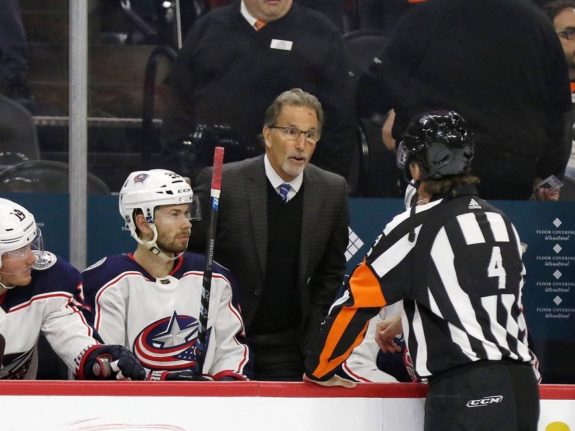
 Cody Chalfan
The Hockey Writers
Cody Chalfan
The Hockey Writers
24
Reads
0
Comments
Power Play Is Key for Blue Jackets’ Postseason Success
The Columbus Blue Jackets pulled off the impossible during the 2019 Stanley Cup Playoffs. They swept the Presidents’ Trophy-winning Tampa Bay Lightning in the first round. The key to the upset was their power play, which struggled during the regular season with a 15.4 percent success rate. In the Lightning series, however, the power play was red hot, 5/10 (50%).
For comparison, in the second round, the Blue Jackets’ power play converted on 14.3 percent of opportunities (3/21). The Boston Bruins won that series 4-2. Interestingly, in the two games that the Blue Jackets won, their power play was 3/7 (42.9%). The rest of the series, they were scoreless on the power play on 14 attempts.
Related: Red Wings’ 3 Best Agitators in the Modern Era
This season is no different, the power play’s success is key for them if they plan on defeating the Toronto Maple Leafs and going on to the Stanley Cup Playoffs. I’ll break down the two different units being used in training camp and analyze how they can contribute to the power play’s success.
The Blue Jackets’ Power Play During the Regular Season
During the 2019-20 regular season, the power play struggled. The Blue Jackets went 31/189 for 16.4 percent. Their power-play percentage was well below the league average of 20 percent. The rest of the league also averaged 41 goals on 208 power-play opportunities, the Blue Jackets’ numbers were much lower.

The struggle becomes more apparent when only two players have five power-play goals, Zach Werenski and Emil Bemstrom. Behind them, Gustav Nyquist, Oliver Bjorkstrand, Cam Atkinson, and Kevin Stenlund scored only three each. There wasn’t a player that stuck out on the man advantage during the season and the Jackets hope to change that this postseason.
Phase 3 Training Camp Power Play Looks
The power play has been a major focus in Phase 3 training camp. Head coach John Tortorella has been making tweaks to the units trying to find what works. The good news is, the problem should be easy to figure out and fix, especially considering the talent that can be found on the roster.
Offense, Jones-Werenski Pairing Highlight
This possible power-play unit was put on the ice during training camp on July 17 and included Pierre-Luc Dubois, Seth Jones, Gustav Nyquist, Oliver Bjorkstrand, and Zach Werenski. Dubois takes the position in front of the net. Jones lines up to the left of center, Nyquist, and Bjorkstrand lines up to the right, while Werenski holds the point. If you need a visual, see the tweet below.
The most interesting aspect here is the potential offense. The line features the Blue Jackets’ top three goal scorers, Bjorkstrand (21), Werenski (20), and Dubois (18). It also features three of the four leading power-play goal scorers, Werenski (5) and Nyquist and Bjorkstrand (3 each). There is no doubt that this kind of firepower could get the power play going in time for the Toronto series.
Another highlight of this unit is that Jones and Werenski are paired together. The top defensive unit could make a huge difference on the power play. They are sound defensively, blocking a combined 181 shots this season and lead a defense that gave up only 60 high-danger chances on the season (3rd in the NHL). Defensively, they will be able to stifle any possible short-handed opportunities.
Related: Top 15 NHL Power Forwards
The pair is also very dangerous offensively. Werenski scored 20 goals and 21 assists, and Jones had six goals and 24 assists. This adds up to 71 points, including 22 power-play points. Werenski’s 20 goals are also good for the league-lead among defensemen. With their offensive ability, the Jones-Werenski pairing will contribute to a sound power play.
The last interesting piece of this unit is Nyquist. He’s listed as a right-winger, but this unit has him at center. This isn’t shocking considering he is third in faceoff win percentage (51.5%) on the team, and second if you don’t include Calvin Thurkauf who only took two faceoffs this season.
Even though Boone Jenner has a higher faceoff win percentage, Nyquist has a higher offensive output with 42 points. His faceoff ability will help a lot with the Blue Jackets’ struggles, getting set up in the offensive zone. Combine that with his offensive output, and he could be key to getting the power play on track.

With the offensive firepower, the defensive chemistry of the Jones-Werenski pair, and Nyquist’s faceoff ability, this power-play unit is dangerous. If they win the faceoff and get set up in the offensive zone, there’s a good chance their opponent will find themselves under siege.
Bemstrom and Atkinson Bring Firepower to Second Unit
The other power-play unit that has been used in training camp is the one shown in the tweet below. Here, instead of Dubois in front of the net, it’s captain Nick Foligno. At the center position is Alexander Wennberg, with Emil Bemstrom to the left of him and Cam Atkinson to the right. Behind them, Ryan Murray runs the point.
Bemstrom is known for his wicked shot, but that’s not the only thing that makes him a threat on the power play. He leads the Blue Jackets with five power-play goals and has shown he’s capable of a hot streak this season. After a down year due to injuries, Atkinson also remains a big threat. Through his career, he has recorded 41 goals and 45 assists on the power play. While not having as much firepower as the first unit, the second one still has no shortage of talent to keep the opponent on their toes.
Another thing to keep an eye on is Foligno being the net-front presence. He plays a physical and gritty style, with 212 hits this season alone. He can use that style of play to win net-front battles and disrupt the opposing goaltender. With that ability, he can serve as a screen, tip-in deflections, and direct pucks on net, all vital for a solid power play.
Related: John MacLean – How He Became a Devils Legend
While not at the level of the Jones-Werenski pairing, Murray could still be quite the factor. He doesn’t have the goal-scoring ability of Werenski and isn’t as consistent as Jones on defense, but he’s still a solid defenseman. He has a plus-13 for his career and also blocked 50 shots and had six takeaways in 27 games this season. Murray will provide great defensive support on this unit for any mistakes that cause short-handed opportunities.

It may not have the talent of the first power-play unit, but it will have the potential to be productive. With the offensive abilities of Atkinson and Bemstrom, Foligno’s net-front presence, and Murray’s ability to protect the line, they should be a solid second unit.
Can the Blue Jackets’ Power Play Rise to the Occasion Like Last Season?
If the Blue Jackets can build a power play like last postseason’s against Tampa, they will be a dangerous team. I believe the units discussed above will find their way against a struggling Maple Leafs penalty kill, which sits at just 77.7 percent. If the power play stays hot, there is a good chance for a series win over Toronto and a deep run in this postseason.
The post Power Play Is Key for Blue Jackets’ Postseason Success appeared first on The Hockey Writers.
Popular Articles

















































 Canucks Vancouver
Canucks Vancouver Sharks San Jose
Sharks San Jose Flames Calgary
Flames Calgary Avalanche Colorado
Avalanche Colorado Coyotes Arizona
Coyotes Arizona Golden Knights Vegas
Golden Knights Vegas Wild Minnesota
Wild Minnesota Red Wings Detroit
Red Wings Detroit Blues St. Louis
Blues St. Louis Blackhawks Chicago
Blackhawks Chicago Blue Jackets Columbus
Blue Jackets Columbus Hurricanes Carolina
Hurricanes Carolina Jets Winnipeg
Jets Winnipeg Predators Nashville
Predators Nashville Ducks Anaheim
Ducks Anaheim Oilers Edmonton
Oilers Edmonton Sabres Buffalo
Sabres Buffalo Rangers New York
Rangers New York Bruins Boston
Bruins Boston Panthers Florida
Panthers Florida Senators Ottawa
Senators Ottawa Lightning Tampa Bay
Lightning Tampa Bay Capitals Washington
Capitals Washington Islanders New York
Islanders New York Devils New Jersey
Devils New Jersey Maple Leafs Toronto
Maple Leafs Toronto Flyers Philadelphia
Flyers Philadelphia Penguins Pittsburgh
Penguins Pittsburgh Stars Dallas
Stars Dallas Kraken Seattle
Kraken Seattle Kings Los Angeles
Kings Los Angeles






